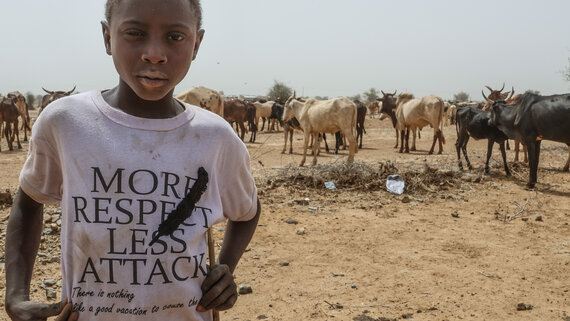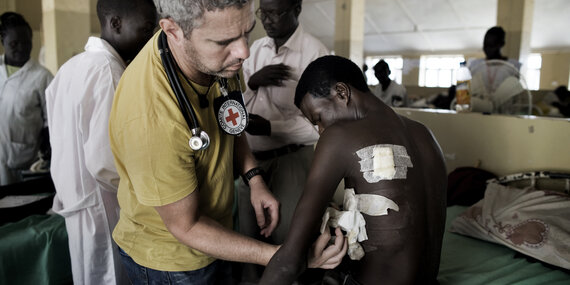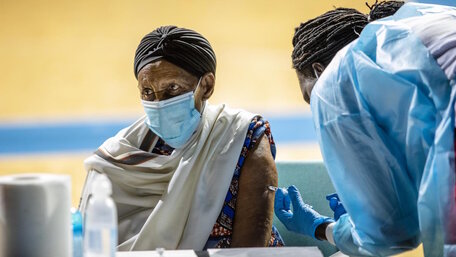Malakal, South Sudan
At Malakal Hospital, South Sudan, an ICRC worker visits a man wounded by gunshot. ICRC/Alessio Romenzi
In 2020, about 60 per cent of all conflicts worldwide were fought violently. Despite repeated calls for global ceasefires due to the COVID-19 pandemic, political conflicts continue to hit civilian populations the hardest and further exacerbate the needs of the most vulnerable categories of people.
The overall number of civilian deaths and injuries from the use of explosive weapons decreased by 43 per cent in 2020 compared to the previous year, yet civilians still account for the most casualties. In 2020, 59 per cent of casualties were civilians, totaling 11,056 deaths and injuries.
Civilians continued to be far more at risk when explosive weapons were used in populated areas. The destruction to essential infrastructure including homes, hospitals, roads and schools has had devastating impacts on civilian populations, driving up displacement and protection risks. Globally, 88 per cent of people harmed by explosive weapons are civilians, a trend that has been observed for the tenth consecutive year. The overall decrease in civilian casualties could be linked to parties shifting focus to the pandemic and related safety measures, as well as ceasefires in Libya and the Syrian Arab Republic.
Casualties from explosive arms incidents (2019-2020)
Children are particularly vulnerable. In 2020, the United Nations verified over 26,000 grave violations against children, including the recruitment and use of children by armed groups, killing, maiming, harassment, rape and sexual violence, abductions and attacks on schools and hospitals.
Persons with disabilities often face difficulties fleeing violence and a higher risk of injury and death. When escaping hostilities, they can struggle to access devices that might usually enable them to carry out daily activities, such as prostheses or mobility aids. Persons with disabilities face challenges meeting basic needs such as food, protection, sanitation and health care, which can be inaccessible even when service provisions are in place. Women and girls with disabilities also experience higher rates of sexual violence.

Tillabéri, Niger
In Niger, as in many other countries in the Sahel, livestock herders face a double threat to their way of life. Pastureland is shrinking at an alarming rate, as climate change raises temperatures and decreases rainfall. At the same time, the presence of armed groups along traditional routes has made it dangerous to roam in search of greener pastures. This young boy is a herder who has settled in Tillabéri. He said: “There never used to be any security problems. We herders went wherever we liked. It was rare to see animals die of hunger. Now the pastures are cut off from us.” Herders who can still migrate with their livestock must do so earlier and earlier in the year and for longer periods as they search for remaining pastureland. Farmers are also struggling to harvest enough grain and vegetables from their fields.
ICRC/Birom SeckYemen is home to at least 4.6 million persons with a disability. As in other countries, they face heightened risks, such as exclusion, discrimination and violence, as well as a lack of representation and access to services. Analysis from eastern Ukraine showed that older persons and persons with disabilities living closer to the front line had significantly lower levels of access to health-care services.
Conflict-related sexual violence continues, mostly targeting women and girls. Survivors face persistent social, structural and security constraints, often leading to negative coping mechanisms, including early and forced marriage. The pandemic has slowed the pace of judicial proceedings in many conflict settings, impacting the already severely limited judicial processes for rape and sexual violence. It is critical that the capacity of national rule of law institutions is strengthened to advance accountability and prevention.
Aid worker security incidents (2010–2020)
Violence against humanitarian workers and assets continues, with most incidents occurring in conflict-affected countries. In 2020, 117 humanitarian workers were killed, 108 of whom were national staff. Attacks against health-care workers are increasing. WHO recorded the killings of 182 health-care workers in 22 countries affected by armed conflict, with the highest numbers in Burkina Faso, DRC, Somalia and the Syrian Arab Republic.
Humanitarian Access Constraints (2018-2021)
Humanitarian access and operations continued to be hampered by conflict, insecurity, violence against humanitarian workers and assets, bureaucratic impediments, counterterrorism, sanctions measures and political attacks, which delegitimize humanitarian response. COVID-19 has also intensified access challenges. Border closures, flight suspensions, lockdowns and other countermeasures cause delays, additional costs and the partial suspensions of some humanitarian activities.
Further reading
Source: Heidelberg Institute for International Conflict Research
Source: Action on Armed Violence
Source: UN Security Council
Source: UN Security Council
References
- Heidelberg Institute for International Conflict Research, Conflict Barometer 2020.
- Political conflict is classified according to its intensity into low, medium or high. Low-intensity political conflict is non-violent; it includes political disputes and non-violent crises. Medium- and high-intensity political conflict includes the use of violence. Specifically, highly violent political conflicts included 21 wars and 19 limited wars. For full definitions on methodology, please see Heidelberg Institute for International Conflict Research, Conflict Barometer 2020.
- Action on Armed Violence, Explosive Violence Monitor 2020, p. 9.
- Report of the UN Secretary-General on the Protection of Civilians in Armed Conflict, S/2021/423, p. 2.
- Report of the UN Secretary-General on Children and Armed Conflict, A/75/873 S/2021/437, 6 May, 2021, p. 2. The highest numbers of grave violations were verified in Afghanistan, the Democratic Republic of the Congo, Somalia, the Syrian Arab Republic and Yemen.
- Report of the UN Secretary-General on the Protection of Civilians in Armed Conflict, S/2021/423, p.7.
- Human Rights Watch, Persons with Disabilities in the Context of Armed Conflict, 8 June 2021
- OCHA, Humanitarian Needs Overview - Yemen, 2021, p. 33
- Report of the UN Secretary-General on the Protection of Civilians in Armed Conflict, S/2021/423, p.7.
- WHO, Access to health-care services for older persons and persons with disabilities living in Eastern Ukraine along the "line of contact" (2021)
- Report of the UN Secretary-General on the Protection of Civilians in Armed Conflict, S/2021/423, p.7.
- Report of the UN Secretary-General on Conflict-Related Sexual Violence, S/2021/312, 30 March 2021
- Aid Worker Security Database, 2020
- Report of the UN Secretary-General on the Protection of Civilians in Armed Conflict, S/2021/423, p. 11.
- Report of the UN Secretary-General on the Protection of Civilians in Armed Conflict, S/2021/423, p. 8.





